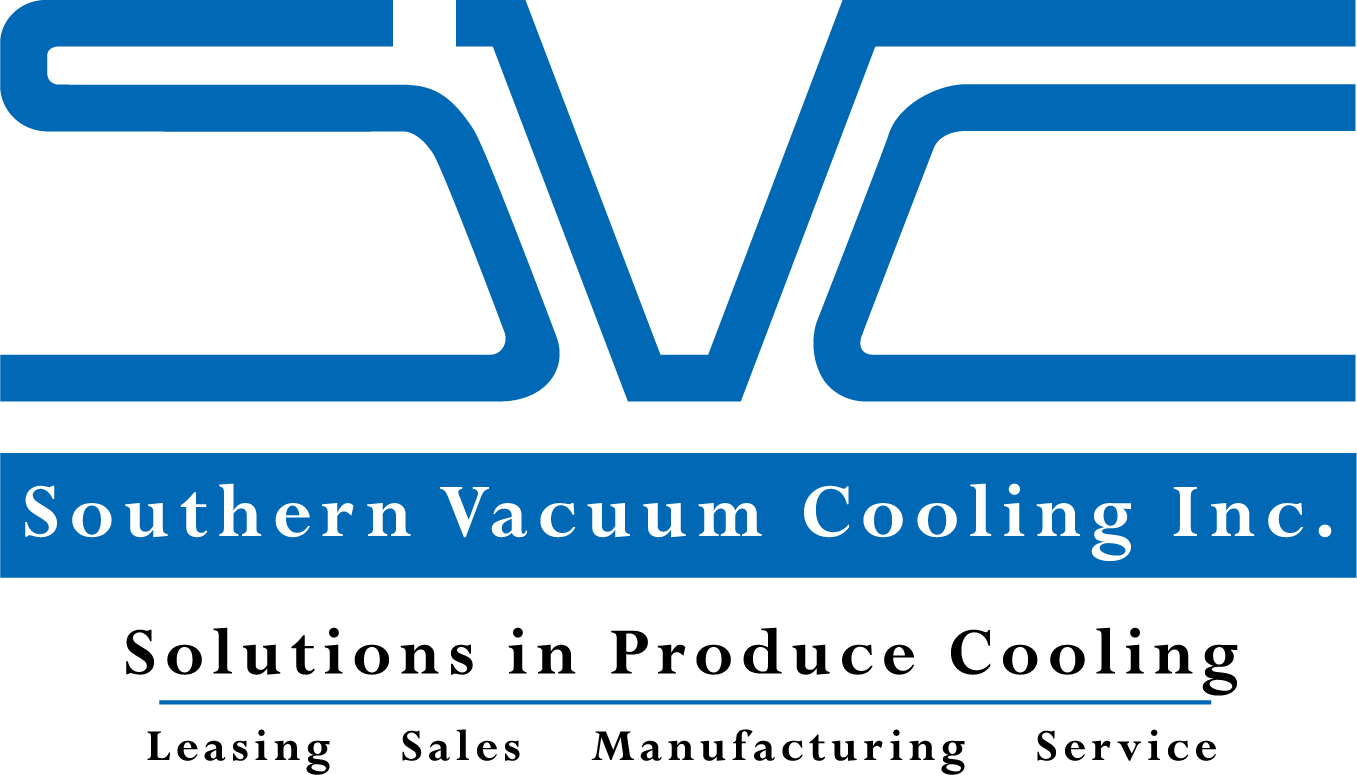The process
Solutions in produce cooling
Leasing Sales Manufacturing Service
What is the
process of vacuum cooling?
The process of vacuum cooling is the rapid refrigeration of a porous product through moisture removal. Once a product is cut, heat and moisture begin to take their toll. The product will begin to rot from the inside out. When placed in a cold room, the heat is removed in a slow continuous process. However with vacuum cooling the heat is removed very rapidly, allowing for earlier shipping and a fresher product. Vacuum cooling uses a vacuum and refrigeration system together to accomplish this goal. After the product is harvested and packaged, it is placed on pallets for shipping. The pallets are loaded into a vacuum-tight chamber and the process begins. The equipment drops the pressure inside the vessel by removing air through vacuum pumps. Once the level of vacuum reaches the “flashpoint” moisture and heat are removed from the product in the form of water vapor. The lower the pressure inside the chamber, the lower the boiling point of water. For example, at sea level, a pot of water boils at 212 degrees F (100 degrees C). The mountains are at a higher elevation and the air is “thinner”, the air is at a lower atmospheric pressure. At lower pressures, the same pot of water will boil at lower temperatures. So in the mountains water could boil at 195 degrees F (95 degrees C). The air being removed lowers the pressure which in turn lowers the boiling point of water. So as the pressure continues to drop, the boiling point will drop. Water will literally start to boil at 60, 50, 40 degrees. This science is duplicated and expanded inside of a vacuum cooler. Inside the vacuum chamber, the air will be removed through a vacuum system. As the vacuum goes deeper, more water vapor is removed and the product temperature is reduced until the desired temperature is achieved. The water vapor must be removed in order for the process to work efficiently. The vacuum draws the water vapor past refrigeration coils which condenses the vapor back into water. These two systems allow the process to achieve the desired product temperature more rapidly than any other post-harvest cooling technique. The rate at which a product can be refrigerated is directly related to the surface area, the density of its tissue and the amount of temperature drop. Typical cooling times range from 20 to 40 minutes at a temperature drop from 80 to 36 degrees Fahrenheit. The average moisture loss is one-percent for each eleven-degree Fahrenheit temperature drop. Since produce is sold by weight, a hydro-vac system can help reduce moisture loss. This works by spraying clean water over the produce during the vacuum cooling cycle.
Products suitable
for vacuum cooling

Bakery
part-baked bread, bread rolls and loaves, pastry, pizza, ect

Vegetables
Lettuce, broccoli, mushrooms, leafy vegetables, corn, herbs

Cooked and Fresh Meat
beef, chicken, turkey, fish

Chilled Ready Meals
Sauces, Soups, Meat Slurries, Fruit Concentrates, liquids
What it can do for you
Vacuum cooling works well on any product that has water and is porous. Water will be removed from the product through its pores. As the water escapes, heat is removed, which cools the product. Historically, vacuum cooling is mostly used in agriculture to quickly cool fruits and vegetables. Let’s take lettuce for example. Lettuce is grown during the summer and is usually harvested in temperatures ranging from 60-80 degrees. The warmer it is, the quicker the lettuce will deteriorate. In order to preserve and maintain the quality of the lettuce, it needs to be refrigerated. Vacuum cooling is the fastest method of refrigerating vegetables. So after harvest, the lettuce is packaged and palletized. The pallets of lettuce are loaded into the vacuum cooling chamber. The vacuum cooling cycle is started.
Due to the rapid post-harvest refrigeration that vacuum cooling allows, the shelf life of the product is extended considerably, thus increasing allowable travel times and opening new markets. Rapidly cooling products will greatly reduce the level of microbiological growth during storage. Vacuum cooling has been documented to have lower levels of microbiological growth than any other cooling method. Products that have gone through vacuum cooling can be shipped and enjoyed anywhere in the world because their quality and shelf life have been improved so dramatically.
Products
suitable for
vacuum cooling
Vacuum cooling equipment has been used with good results to refrigerate and/or dehydrate many products that will dissipate moisture readily, from fresh vegetables and cut flowers to tobacco and alfalfa. We refrigerate lettuce, cabbage, mushrooms, flowers and Asian vegetables on a regular basis. Vacuum cooling has been used in the produce industry for many decades.

